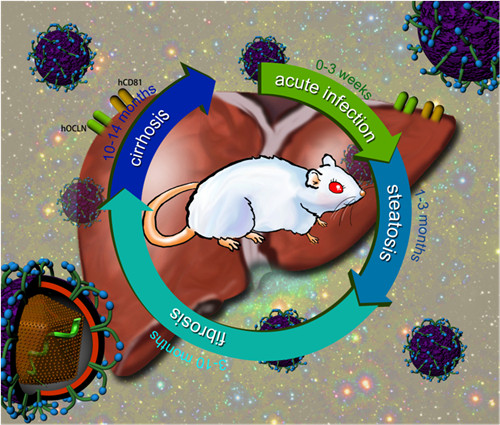An Authentic Mouse Model of Persistent Hepatitis C Virus Infection Becomes Available
Date:08-10-2014 | 【Print】 【close】
Researchers from WIV and Institute of Biophysics, CAS, published a cover story on Cell Research, titled Persistent hepatitis C virus infections and hepatopathologicalmanifestations in immune-competent humanized mice, which reported the world's first immune-competent humanized mice that allow the natural infection of HCV.Almost 40 years ago, HCV was identified by researchers in NIH. There are about 200 million people carrying HCV around the world, among which, there are over 40 million patients in China alone. The majority of HCV infection develops chronic infection, which causes steatosis, cirrhosis and hepatocellular carcinoma. However,understanding HCV chronicity and pathogenesis has been hampered by its narrow host range, mostly restricted to human and chimpanzees.
Endeavor to infect a variety of humanized mice has not been able to achieve persistent HCV infection unless the essential innate immune responsive genes are knocked out. Nevertheless, such immune-compromised humanized mice still lacked HCV infection-induced hepatopathogenesis. Prof. Hong Tang and Prof. Xinwen Chen reported that transgenic mice in ICR background harboring both human CD81 and occludin genes (C/OTg) are permissive to HCV infection at a chronicity rate comparable to humans. In this mouse model, HCV accomplishes its replication cycle, leading to sustained viremia and infectivity for more than 12 months post infection with expected fibrotic and cirrhotic progression. Host factors favorable for HCV replication, and inadequate innate immune-response may contribute to the persistence. Lastly, NS3/4 protease inhibitor telaprevir can effectively inhibit de novo RNA synthesis and acute HCV infection of C/OTg mice. Thus, their most advanced mouse model can recapitulate chronic HCV infection with complete replication cycle and hepatopathologic manifestations. This is for the first time scientists can engineer the immune-competent mice to be permissive to HCV infection. This model will open a new venue to study the mechanisms of chronic hepatitis C and develop better treatments.
http://www.nature.com/cr/journal/vaop/ncurrent/full/cr2014116a.html
